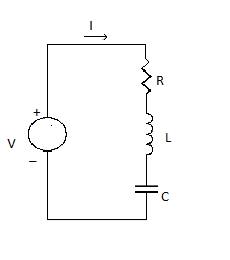Question
Question: The power in series RLC –circuit with AC source is given by A) Zero B) \(VI\operatorname{Sin} \p...
The power in series RLC –circuit with AC source is given by
A) Zero
B) VISinϕ
C) VI
D) VICosϕ
Solution
An RLC series circuit. It shows a resistor R connected in series with an inductor L, connected to a capacitor C in series to an A C source V. The voltage of the A C source is given by V. Here ohm’s law and power factor solve it. Ohm’s law is V=IR and power is equal to IR2
Step by step solution:
Step 1:
The question based on RLC-circuit and it is important to understand about the RLC-circuit and its functioning before getting about its power in series

The figure describes an R LC series circuit. It shows a resistor R connected in series with an inductor L, connected to a capacitor C in series to an A C source V. The voltage of the A C source is given by V.
When a pure resistance of R ohms, a pure inductance of L Henry and a pure capacitance of C farads are connected together in series combination with each other then RLC Series Circuit is formed. As all the three elements are connected in series, the current flowing through each element of the circuit will be the same as the total current I flowing in the circuit.
R is denoted by Vr, L is denoted byVl and C is denoted bVc and in the RLC-circuit
∴ XL =2π fL and Xc =21 π fC
Vπ= IR that is the voltage across the resistance R and is in phase with the current I.
Vi = IXL that is the voltage across the inductance L and it leads the current I by an angle of 90 degrees.
Vc = IXc that is the voltage across capacitor C and it lags the current I by an angle of 90 degrees.
Step 2:
The product of voltage and current is defined as P=VIcosϕ =IR2
Where, cosϕ is the power factor of the circuit and expressed as: cosϕ=vVr =ZR =(Xc−Xl)2+R2R
Hence this is the power in series by the RLC circuit in the AC source.
From the above equation option D is correct.
Note: For a series RLC circuit, an impedance triangle can be drawn by dividing each side of the voltage triangle by its current, I. The voltage drop across the resistive element is equal to IR, the voltage across the two reactive elements is IX = IXL – IXc while the source voltage is equal to IZ.
